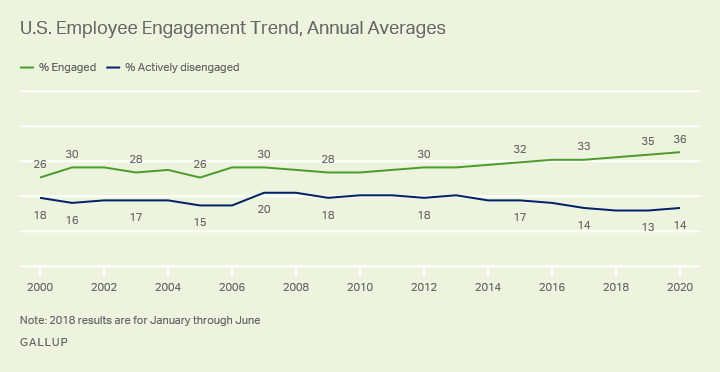Story Highlights
- 2020 saw unprecedented fluctuations in workplace culture worldwide
- Manager development and engagement should be a priority for leaders
- Struggling employee wellbeing links to employee burnout, even for engaged employees
Get the highlights from Gallup's latest study across 112,312 business units that finds important ties between employee engagement and 11 performance outcomes -- including profitability and employee wellbeing.
Gallup is closely tracking the engagement and wellbeing of the workforce during this unprecedented time of disruption. We are providing the latest updates for organizational leaders so they can understand the impact on the workplace and what their people need most during this time of rapid change.
After a rollercoaster 2020, U.S. employee engagement increased to 39% in January, up from 36% late last year.
While engagement growth has been slow and steady in the past decade, the disruptions of 2020 brought never-before-seen fluctuations in workplace cultures. The percentage of engaged workers in the U.S. has generally been a steady metric since Gallup began tracking nationally representative samples of workers starting in 2000.
In early March, as work and life were first disrupted due to COVID-19, the overall wellbeing of Americans declined sharply. Yet employee engagement remained a steady rock -- up to 37% in March from 35% in 2019.
Through mid-May, employee engagement increased even further to 38%. And then, after the protests and societal upheavals surrounding the George Floyd killing, engagement dropped to 31% in June, a record short-term drop. Engagement of workers dropped most significantly for managers, leaders, non-White respondents and those with Democratic political party affiliation or independents. The drop was also sharper for people working on-site versus at home and among blue-collar or service workers. The drop was larger for men than women.
These declines in employee engagement in early June appear to have been short-lived disruptions to the workplace. All the sub-categories where Gallup measured the most substantial engagement drops in early to mid-June, saw significant rebounds. The engagement of U.S. workers in late June and early July then reversed course to a record level of 40% engaged. Then in mid-July through September, rates reverted to the early COVID-19 level of 36% engaged.
In aggregate, the percentage of engaged employees in 2020 -- those who are highly involved in, enthusiastic about and committed to their work and workplace -- dropped back to just slightly above the pre-coronavirus rate of 35% to 36% for the year.
The percentage of workers who are "actively disengaged" -- those who have miserable work experiences and spread their unhappiness to their colleagues -- increased slightly from 2019 to 2020, from 13% to 14%. The ratio of engaged to actively disengaged workers in 2020 was 2.6-to-1, down slightly from a 2.7-to-1 ratio in 2019. The overall 2020 findings are based on a random sample of 34,557 full- and part-time U.S. employees working for an employer from March through December 2020.
After a rollercoaster 2020, U.S. employee engagement increased to 39% in January, up from 36% late last year.
And now, as noted earlier -- based on a sampling of workers from January 2021 -- 39% of U.S. workers are engaged while 14% are actively disengaged. This presents a 2.8-to-1 ratio of engaged to actively disengaged workers, which if it were to hold for all of 2021 would be another new record level of employee engagement in the U.S. The early 2021 findings are based on a random sample of 2,061 full- and part-time U.S. employees working for an employer.

Important Developments During COVID-19:
1. Employees say they are getting more feedback. Forty-five percent of employees say they have gotten feedback from their manager either daily or a few times per week. This is up from 26% in 2019. But only 28% strongly agree they received meaningful feedback in the past week, up from 19% in 2019. Gallup has found meaningful feedback is a critical factor in the engagement of all workers, especially remote ones.
2. Engagement among "hybrid" employees has improved. Prior to the COVID-19 pandemic, employees who work remotely at least some of the time had the highest levels of engagement. This continued during 2020, and engagement increased by two percentage points to 43% in the second half of last year.
In 2020, 38% of those who worked from home all or nearly all of the time were engaged, compared to 32% of those who worked on-site all or nearly all of the time. Fifty-six percent of workers continue to work remotely at least some of the time in January 2021. Among them, 44% have found remote working to be a preference going forward, while 39% would prefer to go back to working in an office once restrictions are lifted.
3. Those who work from home all or nearly all of the time reported higher burnout. In 2019, 18% of people who fully worked from home reported burnout very often or always -- lower than those who worked from home some or none of the time. In 2020, 29% of people who fully worked from home reported burnout very often or always -- higher than those who worked from home some or none of the time.
4. Engaged workers are at risk if wellbeing is low. Engaged employees who are struggling or suffering in their overall lives have a 61% higher rate of burnout often or always. In 2020, 47% of employees strongly agreed that their organization cares about their overall wellbeing. Approximately half of employees strongly agreed their organization did a good job of communicating a plan of action in response to COVID-19 (47%), that they felt well-prepared to do their jobs (51%), and that their supervisor kept them informed (47%). Communication within organizations is a central factor in whether or not employees feel cared about.
5. Manager engagement is too low. In 2020, manager engagement, already low, declined from 34% to 33% in the first to second half of the year. The engagement of managers is critical because they set the tone for the engagement of the people who report to them -- managers affect 70% of the variance in team engagement. They are responsible for keeping employees informed on what is going on in the organization, setting priorities, and providing ongoing feedback and accountability. The decreases in engagement during June of 2020 were associated with declines in manager engagement.
The Bottom Line
Leading and managing people in organizations has taken on new significance this past year. Leadership has never been more difficult -- and it has never been more important. There are several challenges that add to the complexity of leadership, and managing, going forward:
- Trying to predict what the future holds on for vaccine distribution and use, and the transition of workplace policies and practices throughout the coming months and years.
- Work and life are more blended than ever. The new challenge of organizational culture is to address what organizations can do for the whole person -- not just the worker -- because all aspects of wellbeing matter to workplace culture, resiliency, and performance including career, social, financial, physical and community wellbeing.
- The Sustainability Accounting Standards Board (SASB), World Economic Forum and many other organizations are promoting standards for environmental, societal, and governance (ESG). These include principles that integrate governance, care for the planet, people and prosperity. Real organizational responsibility on ethics, diversity, wellbeing and the environment will affect employment and marketplace brand more than ever going forward. Accountability has never been higher.
Despite the ups and downs of employee engagement in 2020, in aggregate, workers continue to be more engaged in their work and workplaces. But it is difficult to imagine engagement continuing to improve if manager engagement doesn't also improve. There are very few organizational initiatives that don't flow through managers, including all the challenges noted above. Trust in leadership depends on quality managing.
Teams with engaged managers are more likely to be engaged. And teams with higher engagement achieve a whole host of important business outcomes, higher resiliency during tough times, and higher wellbeing. Gallup's research also demonstrates that more engaged teams have higher organizational citizenship, which is especially important with new ESG standards. No organization can assure low risk on ethics and compliance, DEI, environment and wellbeing without highly skilled managers who, themselves, are developing.
Gallup will continue to track the engagement and wellbeing of the workforce during these unprecedented times of disruption and change and continue to provide the latest updates for organizational leaders.
Is manager development and engagement your No. 1 priority?
- Learn how Gallup can help grow your managers.
- What do managers experience, anyway?
- Is employee engagement really that important? Find out for yourself.



